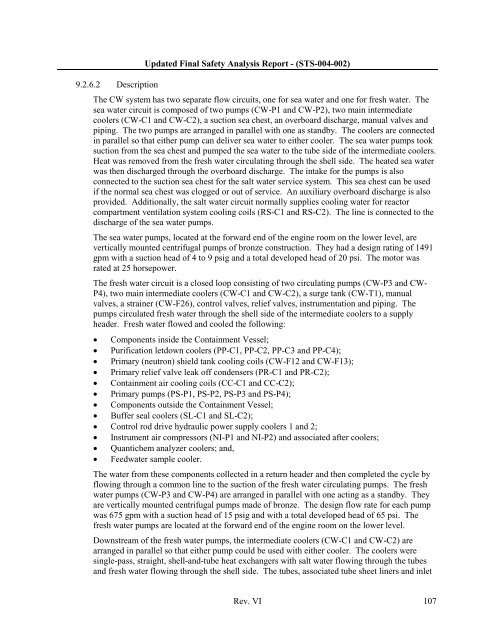10 CFR 50.71(e) - Maritime Administration - U.S. Department of ...
10 CFR 50.71(e) - Maritime Administration - U.S. Department of ...
10 CFR 50.71(e) - Maritime Administration - U.S. Department of ...
Create successful ePaper yourself
Turn your PDF publications into a flip-book with our unique Google optimized e-Paper software.
9.2.6.2 DescriptionUpdated Final Safety Analysis Report - (STS-004-002)The CW system has two separate flow circuits, one for sea water and one for fresh water. Thesea water circuit is composed <strong>of</strong> two pumps (CW-P1 and CW-P2), two main intermediatecoolers (CW-C1 and CW-C2), a suction sea chest, an overboard discharge, manual valves andpiping. The two pumps are arranged in parallel with one as standby. The coolers are connectedin parallel so that either pump can deliver sea water to either cooler. The sea water pumps tooksuction from the sea chest and pumped the sea water to the tube side <strong>of</strong> the intermediate coolers.Heat was removed from the fresh water circulating through the shell side. The heated sea waterwas then discharged through the overboard discharge. The intake for the pumps is alsoconnected to the suction sea chest for the salt water service system. This sea chest can be usedif the normal sea chest was clogged or out <strong>of</strong> service. An auxiliary overboard discharge is alsoprovided. Additionally, the salt water circuit normally supplies cooling water for reactorcompartment ventilation system cooling coils (RS-C1 and RS-C2). The line is connected to thedischarge <strong>of</strong> the sea water pumps.The sea water pumps, located at the forward end <strong>of</strong> the engine room on the lower level, arevertically mounted centrifugal pumps <strong>of</strong> bronze construction. They had a design rating <strong>of</strong> 1491gpm with a suction head <strong>of</strong> 4 to 9 psig and a total developed head <strong>of</strong> 20 psi. The motor wasrated at 25 horsepower.The fresh water circuit is a closed loop consisting <strong>of</strong> two circulating pumps (CW-P3 and CW-P4), two main intermediate coolers (CW-C1 and CW-C2), a surge tank (CW-T1), manualvalves, a strainer (CW-F26), control valves, relief valves, instrumentation and piping. Thepumps circulated fresh water through the shell side <strong>of</strong> the intermediate coolers to a supplyheader. Fresh water flowed and cooled the following: Components inside the Containment Vessel; Purification letdown coolers (PP-C1, PP-C2, PP-C3 and PP-C4); Primary (neutron) shield tank cooling coils (CW-F12 and CW-F13); Primary relief valve leak <strong>of</strong>f condensers (PR-C1 and PR-C2); Containment air cooling coils (CC-C1 and CC-C2); Primary pumps (PS-P1, PS-P2, PS-P3 and PS-P4); Components outside the Containment Vessel; Buffer seal coolers (SL-C1 and SL-C2); Control rod drive hydraulic power supply coolers 1 and 2; Instrument air compressors (NI-P1 and NI-P2) and associated after coolers; Quantichem analyzer coolers; and, Feedwater sample cooler.The water from these components collected in a return header and then completed the cycle byflowing through a common line to the suction <strong>of</strong> the fresh water circulating pumps. The freshwater pumps (CW-P3 and CW-P4) are arranged in parallel with one acting as a standby. Theyare vertically mounted centrifugal pumps made <strong>of</strong> bronze. The design flow rate for each pumpwas 675 gpm with a suction head <strong>of</strong> 15 psig and with a total developed head <strong>of</strong> 65 psi. Thefresh water pumps are located at the forward end <strong>of</strong> the engine room on the lower level.Downstream <strong>of</strong> the fresh water pumps, the intermediate coolers (CW-C1 and CW-C2) arearranged in parallel so that either pump could be used with either cooler. The coolers weresingle-pass, straight, shell-and-tube heat exchangers with salt water flowing through the tubesand fresh water flowing through the shell side. The tubes, associated tube sheet liners and inletRev. VI <strong>10</strong>7
















